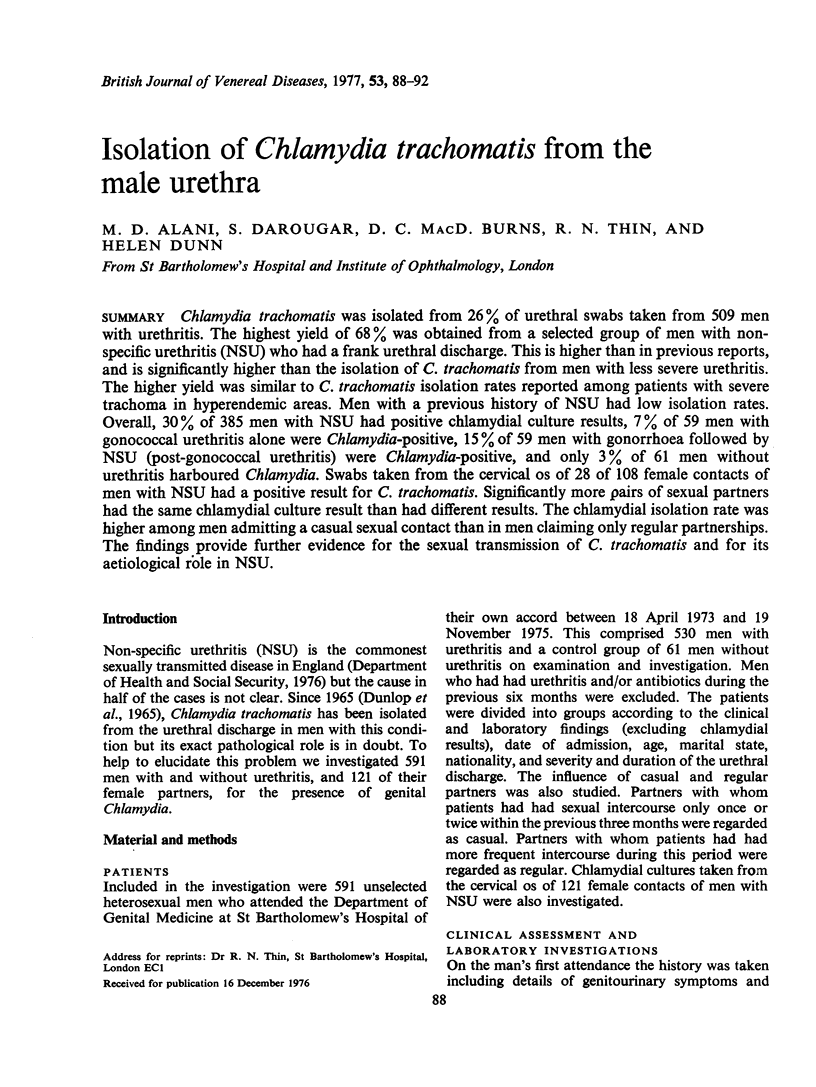Abstract
Chlamydia trachomatis was isolated from 26% of urethral swabs taken from 509 men with urethritis. The highest yield of 68% was obtained from a selected group of men with nonspecific urethritis (NSU) who had a frank urethral discharge. This is a higher than in previous reports, and is significantly higher than the isolation of C. trachomatis from men with less severe urethritis. The higher yield was similar to C. trachomatis isolation rates reported among patients with severe trachoma in hyperendemic areas. Men with a previous history of NSU had low isolation rates. Overall, 30% of 385 men with NSU had positive chlamydial culture results, 7% of 59 men with gonococcal urethritis alone were Chlamydia-positive, 15% of 59 men with gonorrhoea followed by NSU (post-gonococcal urethritis) were Chlamydia-positive, and only 3% of 61 men without urethritis harboured Chlamydia. Swabs taken from the cervical os of 28 of 108 female contacts of men with NSU had a positive result for C. trachomatis. Significantly more pairs of sexual partners had the same chlamydial culture result than had different results. The chlamydial isolation rate was higher among men admitting a casual sexual contact than in men claiming only regular partnerships. The findings provide further evidence for the sexual transmission of C. trachomatis and for its aetiological role in NSU.
Full text
PDF




Selected References
These references are in PubMed. This may not be the complete list of references from this article.
- Burns D. C., Darougar S., Thin R. N., Lothian L., Nicol C. S. Isolation of Chlamydia from women attending a clinic for sexually transmitted disease. Br J Vener Dis. 1975 Oct;51(5):314–318. doi: 10.1136/sti.51.5.314. [DOI] [PMC free article] [PubMed] [Google Scholar]
- DUNLOP E. M., AL-HUSSAINI M. K., GARLAND J. A., TREHARNE J. D., HARPER I. A., JONES B. R. INFECTION OF URETHRA BY TRIC AGENT IN MEN PRESENTING BECAUSE OF "NON-SPECIFIC" URETHRITIS. Lancet. 1965 May 29;1(7396):1125–1128. doi: 10.1016/s0140-6736(65)91954-9. [DOI] [PubMed] [Google Scholar]
- Darougar S., Jones B. R., Kinnison J. R., Vaughan-Jackson J. D., Dunlop E. M. Chlamydial infection. Advances in the diagnostic isolation of Chlamydia, including TRIC agent, from the eye, genital tract, and rectum. Br J Vener Dis. 1972 Dec;48(6):416–420. doi: 10.1136/sti.48.6.416. [DOI] [PMC free article] [PubMed] [Google Scholar]
- Dunlop E. M., Vaughan-Jackson J. D., Darougar S. Chlamydial infection. Improved methods of collection of material for culture from the urogenital tract and rectum. Br J Vener Dis. 1972 Dec;48(6):421–424. doi: 10.1136/sti.48.6.421. [DOI] [PMC free article] [PubMed] [Google Scholar]
- Dunlop E. M., Vaughan-Jackson J. D., Darougar S., Jones B. R. Chlamydial infection. Incidence in 'non-specific' urethritis. Br J Vener Dis. 1972 Dec;48(6):425–428. doi: 10.1136/sti.48.6.425. [DOI] [PMC free article] [PubMed] [Google Scholar]
- Flynn J., Waitkins S. A. A serum-free medium for testing fermentation reactions in Neisseria gonorrhoeae. J Clin Pathol. 1972 Jun;25(6):525–527. doi: 10.1136/jcp.25.6.525. [DOI] [PMC free article] [PubMed] [Google Scholar]
- Gordon F. B., Harper I. A., Quan A. L., Treharne J. D., Dwyer R. S., Garland J. A. Detection of Chlamydia (Bedsonia) in certain infections of man. I. Laboratory procedures: comparison of yolk sac and cell culture for detection and isolation. J Infect Dis. 1969 Oct;120(4):451–462. doi: 10.1093/infdis/120.4.451. [DOI] [PubMed] [Google Scholar]
- Holmes K. K., Handsfield H. H., Wang S. P., Wentworth B. B., Turck M., Anderson J. B., Alexander E. R. Etiology of nongonococcal urethritis. N Engl J Med. 1975 Jun 5;292(23):1199–1205. doi: 10.1056/NEJM197506052922301. [DOI] [PubMed] [Google Scholar]
- Oriel J. D., Reeve P., Powis P., Miller A., Nicol C. S. Chlamydial infection. Isolation of Chlamydia from patients with non-specific genital infection. Br J Vener Dis. 1972 Dec;48(6):429–436. doi: 10.1136/sti.48.6.429. [DOI] [PMC free article] [PubMed] [Google Scholar]
- Oriel J. D., Reeve P., Wright J. T., Owen J. Chlamydial infection of the male urethra. Br J Vener Dis. 1976 Feb;52(1):46–51. doi: 10.1136/sti.52.1.46. [DOI] [PMC free article] [PubMed] [Google Scholar]
- Richmond S. J., Hilton A. L., Clarke S. K. Chlamydial infection. Role of Chlamydia subgroup A in non-gonococcal and post-gonococcal urethritis. Br J Vener Dis. 1972 Dec;48(6):437–444. doi: 10.1136/sti.48.6.437. [DOI] [PMC free article] [PubMed] [Google Scholar]
- Riddell R. H., Buck A. C. Trimethoprim as an additional selective agent in media for the isolation of N. gonorrhoeae. J Clin Pathol. 1970 Sep;23(6):481–483. doi: 10.1136/jcp.23.6.481. [DOI] [PMC free article] [PubMed] [Google Scholar]
- Schachter J., Hanna L., Hill E. C., Massad S., Sheppard C. W., Conte J. E., Jr, Cohen S. N., Meyer K. F. Are chlamydial infections the most prevalent venereal disease? JAMA. 1975 Mar 24;231(12):1252–1255. [PubMed] [Google Scholar]


